コラム
落合憲弘
John Sypal
タカザワケンジ
なぎら健壱

According to the Tokyo Metropolitan Tokyo Metropolitan Government Bureau of Construction, there are 12,004 kilometers of roads squiggle-packed inside the 23 special wards of Tokyo prefecture. However, that only considers what’s on the ground laid out in a line. Since photographers are more concerned with what they can see along the sides of the streets than they are the length of concrete they walk on. So, unless you’re a literal street photographer, for the purposes of this article, we need to account for the right and left sides of the road. To do so we’ll double that total- meaning that anyone with a camera in Tokyo has some 24,008 kilometers of storefronts, apartments, housing, shrines, and what-not to consider through their viewfinder. To put that in perspective, that’s a line of potentially photographable Tokyo sidewalk that wraps itself well over halfway around the planet.
東京都建設局によると、東京23区内に張り巡らせている歩道の距離を合計すると、12,004kmもあるそうです。とはいえ写真家は歩く距離よりも、文字通りのストリート・フォトグラファーでない限り、歩道から何が見えるのかに関心があります。歩道は右側と左側、どちらを歩くかによって見える景色も変わります。つまり東京でカメラを持っている人は、歩道の左右を合わせた24,008km、店先、アパート、住宅、神社、その他をファインダー越しに見ることになります。この数字は、東京の歩道が地球を半分以上ぐるりと囲んでいることを意味します。
In terms of surface area, these 23 special wards cover 627 square kilometers. That’s a lot of ground to cover with a camera. If that wasn’t enough, this ever-unfinished, mega-metropolis is in a constant state of construction and destruction. Not only is there more than any one person can ever see in a lifetime, everything’s in a sped-up state of flux. Quite simply, the city offers infinite photographic possibilities.
And yet- looking through photobooks that deal with Tokyo, it’s fascinating how time and time again certain locations and vantage points possess oddly specific gravities that draw in photographers.
東京23区の面積は627km²、撮影するにはかなりの広さです。さらに、この未完成のメガ・メトロポリスは建設と破壊の絶え間ない状態にあります。一人の人間が一生かかっても見ることができないほど多くのものがあるだけでなく、すべてが加速度的に変化しているのです。簡単に言えば、この街には無限の写真の可能性があります。それでいて東京を扱った写真集を見ていると、特定の場所や見晴らしの良い場所が、写真家を惹きつける重力のような力を持っていることに気がつき、つい魅了されてしまいます。
Personally, there is a real pleasure to be had in discovering these connections, and I’d like to share with you some here. It’s important to note that since the pictures below are pulled from my personal photobook collection, the scope is naturally limited. Certainly, there are potentially many more published -and thousands of unseen examples of each location out there. (If you are aware of any, please let me know!)
個人的には、こうしたつながりを発見することに醍醐味があるので、ここでいくつか紹介したいと思います。以下の写真は私の個人的なフォトブックコレクションから抜粋したものであるため、当然ながら範囲は限られていることに注意していただきたい。確かに、世の中にはもっと多くの、そして何千という、それぞれの場所の未公開例が出版されている可能性があります。ご存知の方はぜひ教えてください!
Let’s start our tour at the Imperial Palace.
では、皇居から今回の「写真繋ぎツアー」を始めましょう。
Despite being such a wide-open (for Tokyo) space, I know for a fact that the eastern Palace grounds have a dense photographic history. A lot of history has happened in these acres, and a photobook of pictures taken here could be quite thick. (In fact, I previously wrote about some of them here: https://photoandculture-tokyo.com/contents.php?i=2062 )
東京にしては広大な敷地であるにもかかわらず、東宮御所には濃密な写真の歴史があります。この場所で撮影された写真を集めた写真集はかなり分厚いものになることでしょう。以前この場所についてコラムを書いたので、ぜひそちらもご覧ください。
Tokyo Photobook Tour>17 特定の場所から見る東京:皇居の東側に架かる「二重橋」をめぐる写真集たち
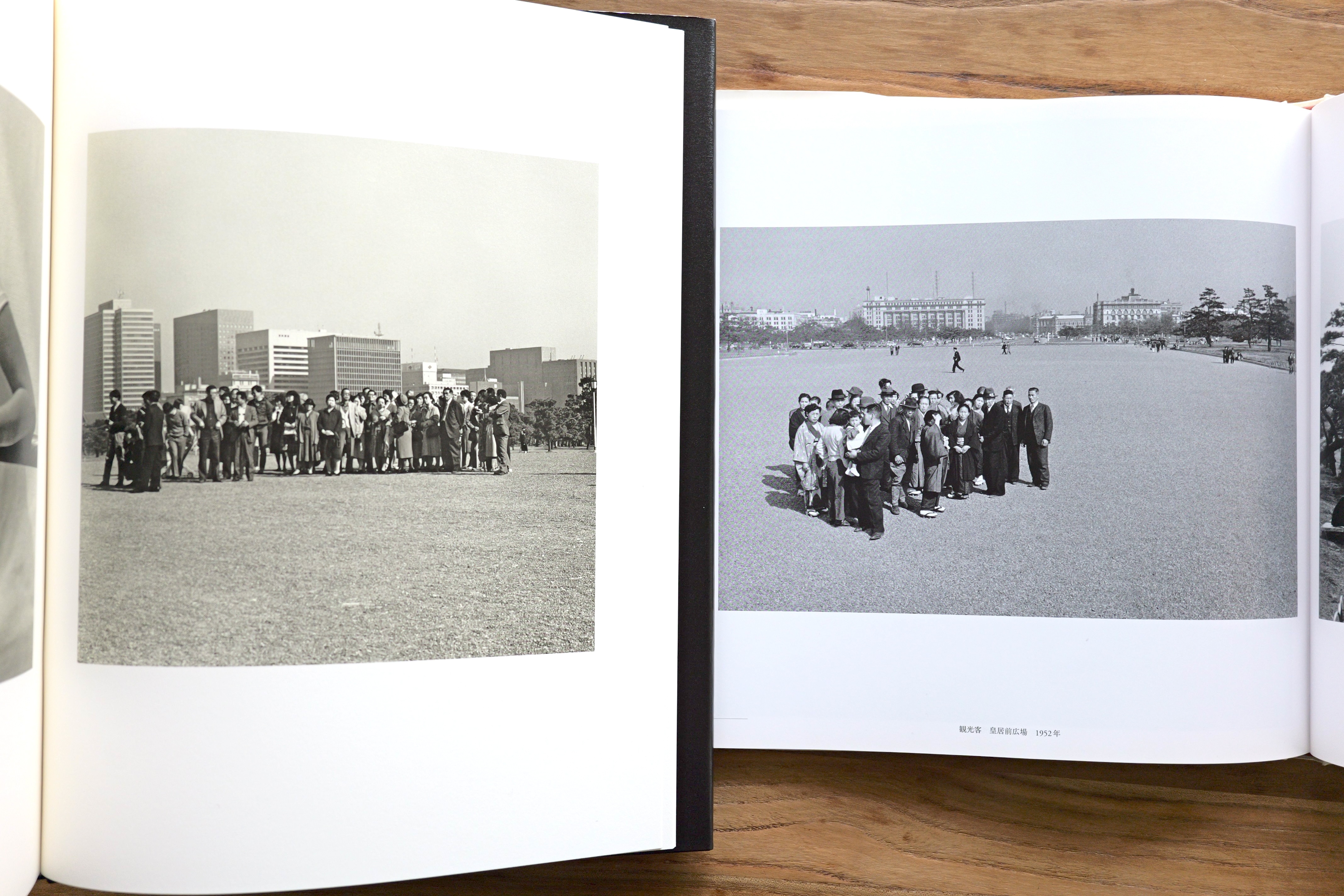
The tour group picture on the left, taken in the 1970s or 1980s, is by Issei Suda, and appears in his book Tokyo Kei (Zen Foto Gallery, 2013). There is a similar group of visitors in the photograph on the right. It was taken in 1952 by Shigeichi Nagano, and is in his book “1950’s Tokyo” (Iwanami Shoten, 2007 ).
Both images share the visual irony as these people stand clumped together with so much space to spread out. Yet, considering the context- the pictures are less about space as they are positions in social status and history. Presumably the people are subjects in proximity of the home of their emperor- some have their hands held politely in front- a sign of slight trepidation or reverence. Upon closer inspection, you can see that, despite seeming like a faceless group from a distance, each member has their own individual expression and thoughts.
写真左の集合写真は1970年代か1980年代に撮影されたもので、須田一政の著書『東京景』(Zen Foto Gallery、2013年)に掲載されています。右の写真にも同じような団体客が写っています。これは長野重一が1952年に撮影したもので、写真集『1950年代の東京』(岩波書店、2007年)に収録されています。どちらも広々としたスペースがあるにもかかわらず、人々が固まって立っているという視覚的な皮肉が共通しています。しかし文脈を考えてみると、この写真は空間というよりも、社会的地位や歴史における位置の問題です。人々は皇族の家の近くにいる一般市民です。遠目には無表情な集団に見えますが、よく見るとそれぞれ個性的な表情をしています。
Here are two more compositionally similar photos, taken in Ueno Park from just about the same spot on the bank of Shinobazu pond.
上野公園・不忍池のほとりのほぼ同じ場所から撮った、構図が似ている2枚の写真があります。

Left: Kazuyoshi Usui, Showa 99 (Zen Foto Gallery, 2024)
Right: Yuta Fuchikami, Ueno Park (Self Published, 2023)
左:薄井一議『昭和99年』(Zen Foto Gallery, 2024年)
右:淵上裕太『上野公園』(塩竈フォトフェスティバル 、2023年)
Both photographs look west, towards the million-dollar condo towers on the other side of the pond. The lotus leaves suggest that Usui’s was taken in late summer, while Fuchikami’s was shot in late winter, sometime after the city’s annual removal of dry stalks near the bank of the pond.
どちらの写真も西を向いており、池の対岸にある100万ドルのタワマンの方を見ています。蓮の葉の様子から、薄井さんの写真は夏の終わりに、淵上さんの写真は冬の終わりに撮影されたものと思われます。

This part of Shinobazu pond seems made for photographs- at any given time you’ll find a visitors snapping the scene with their smartphone. Indeed, Ueno Park enjoys an enormous legacy in Tokyo’s photographic history. Under a hundred meters or so away from the pond there is a wide set of stairs that lead up to the park’s highest plateau.
不忍池のこの一角は写真のためにあるようで、いつ訪れてもスマートフォンで写真を撮っている人がいます。上野公園は、東京の写真の歴史において、非常に大きな遺産です。この池から100メートルほど離れたところに、公園で最も高い台地へと続く広い階段があります。
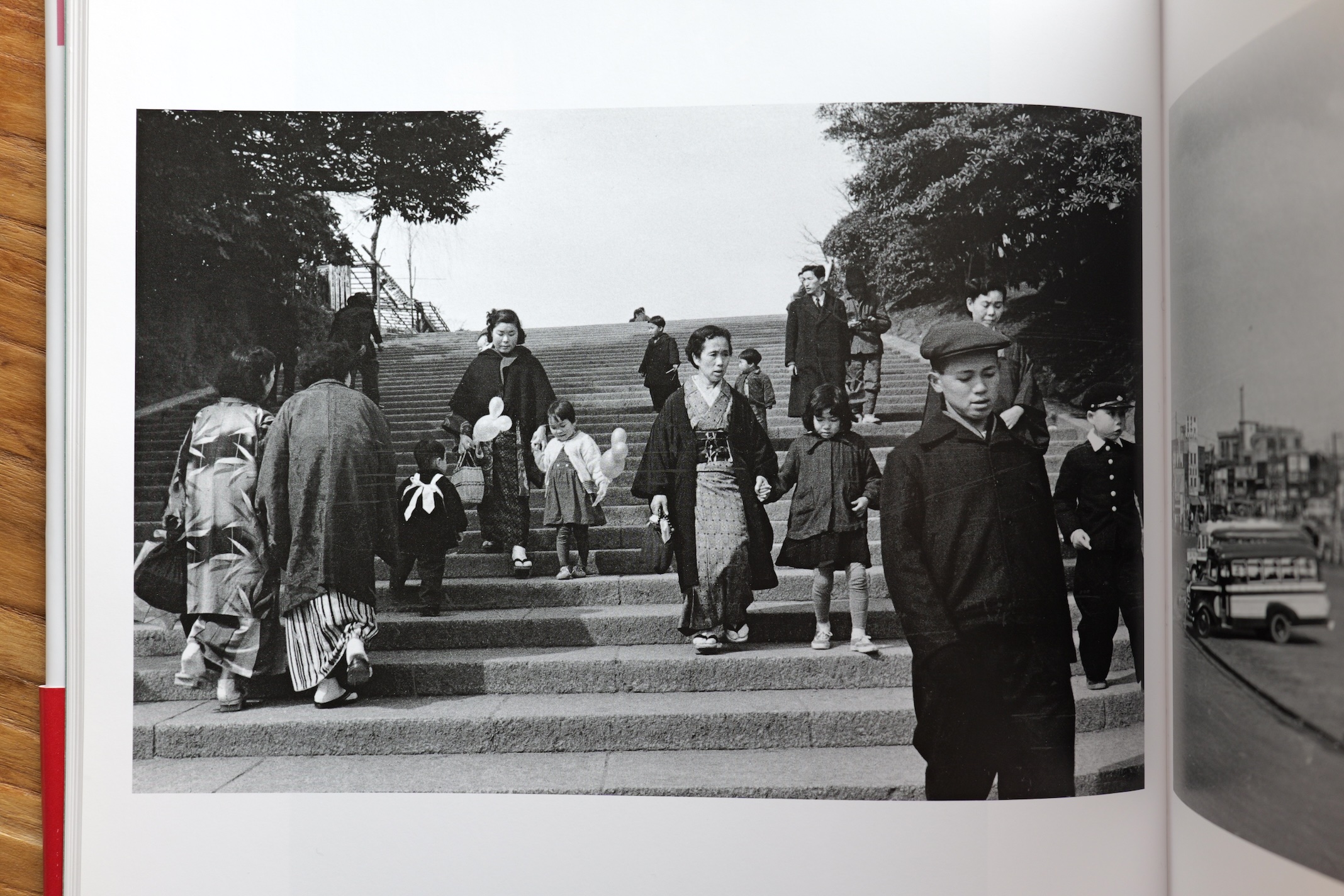
This is another of Shigeichi Nagano’s snapshots from 1952.
これも1952年に撮影された長野重一のスナップです。
Even without the caption, I recognized this staircase the moment I opened the page. The picture brought to mind a photo by Mitsugu Ohnishi that appears in his “Tokyo Heat Map 1997-2004” (Zen Foto Gallery, 2021).
キャプションを読まなくても、写真集のページを開いた瞬間にこの階段だとわかりました。この写真を見て、大西みつぐ『路上の温度計 1997-2004』に掲載されている写真を思い出しました。

大西みつぐ『路上の温度計 1997-2004』(Zen Foto Gallery、2021年)
Putting them together creates a mini panorama across time:
2枚を並べると「時」を超えたパノラマが現れます。
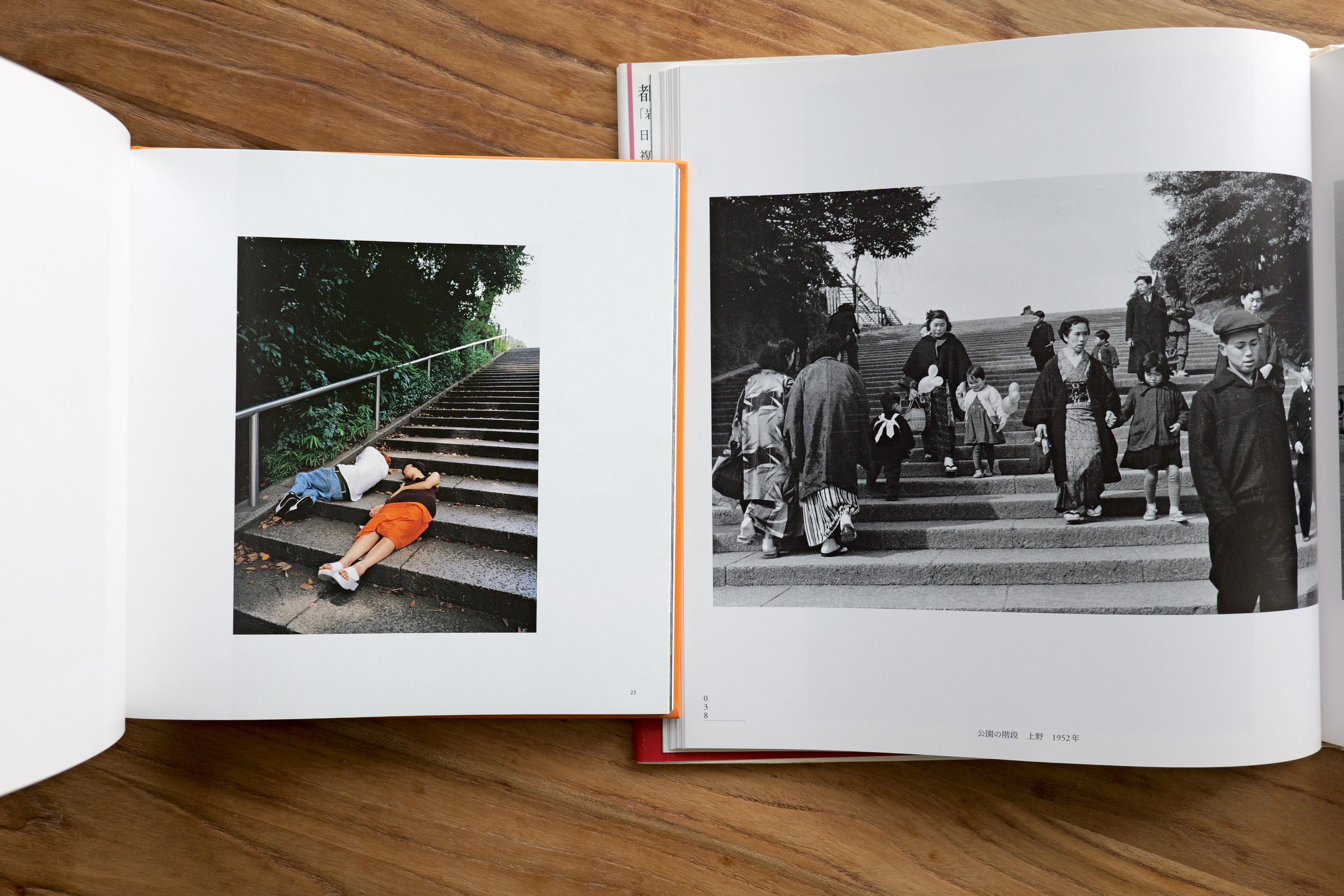

Here’s the same location in 2025:
2025年の同じ階段。
Aside from updated railings and more international tourists, not much has changed. Hundreds, if not thousands, of people ascend these steps each day to see one of Tokyo’s most iconic statues, the 3.7 meter bronze rendition of Samurai-nobleman Saigo Takamori.
手すりが新しくなり、インバウンド観光客が増えたことを除けば、さほど大きな変化はありません。東京で最も象徴的な像のひとつである3.7メートルの西郷隆盛を見るために、毎日何百もの人々がこの階段を上っています。
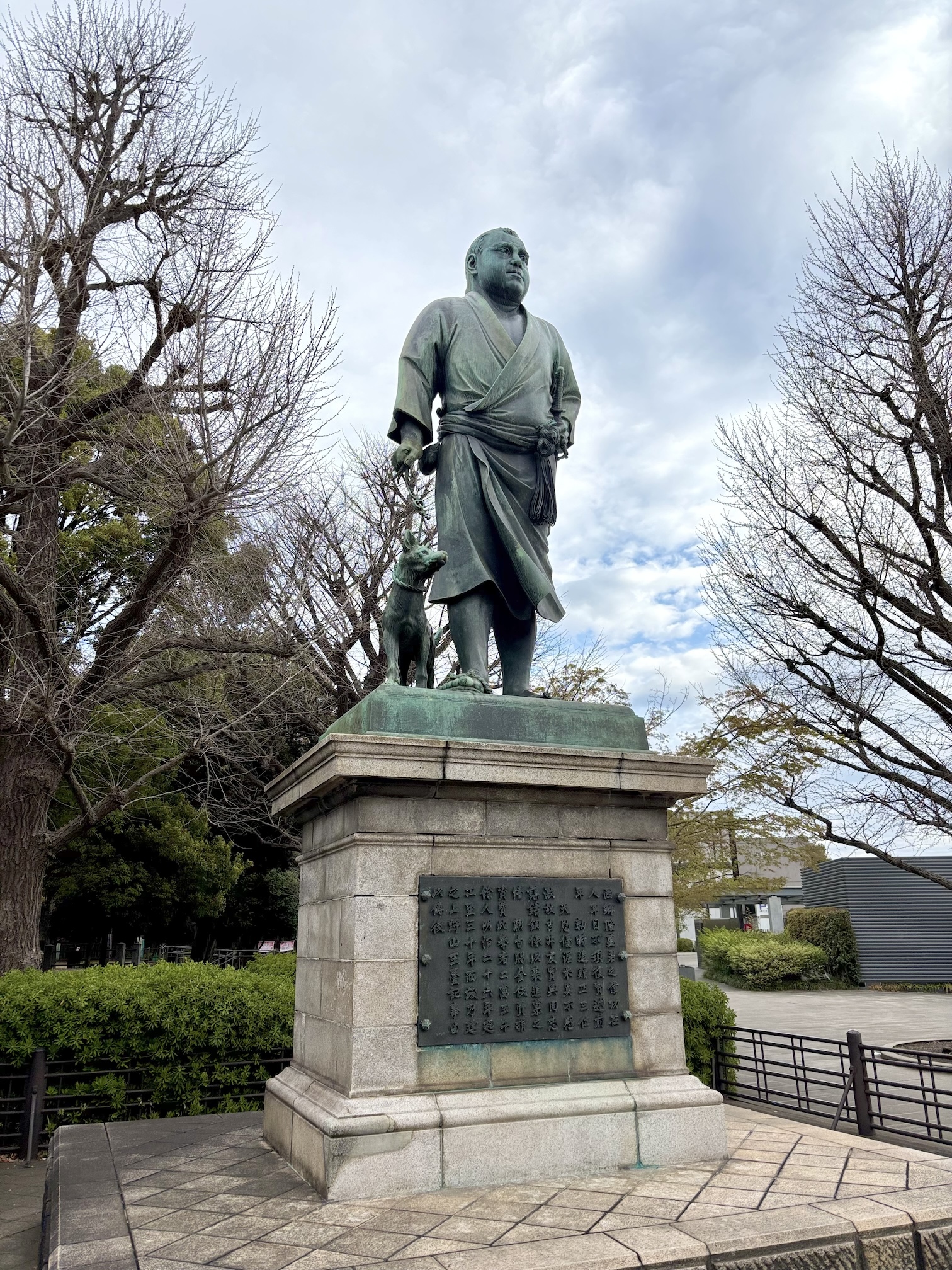
This statue was erected in 1898 to commemorate Saigo’s influence on modern Japanese history- rather than a stoic warrior in armor on horseback he gazes out over Ueno in a yukata pasued on a walk with his dog, Tsun. (It is said that his widow was aghast that he was portrayed so underdressed.) For Tokyoites you could say that this statue enjoys the iconic, representative status that the Statue of Liberty does for New Yorkers.
この銅像は、西郷が日本の近代史に与えた影響を記念し1898年に建てられたもので、甲冑を着て馬に乗ったストイックな姿ではなく、愛犬のツンと散歩する浴衣姿の西郷が上野の街を眺めている様子です。彼の妻は、彼があまりに着飾らない姿で描かれたことに愕然したそうです。
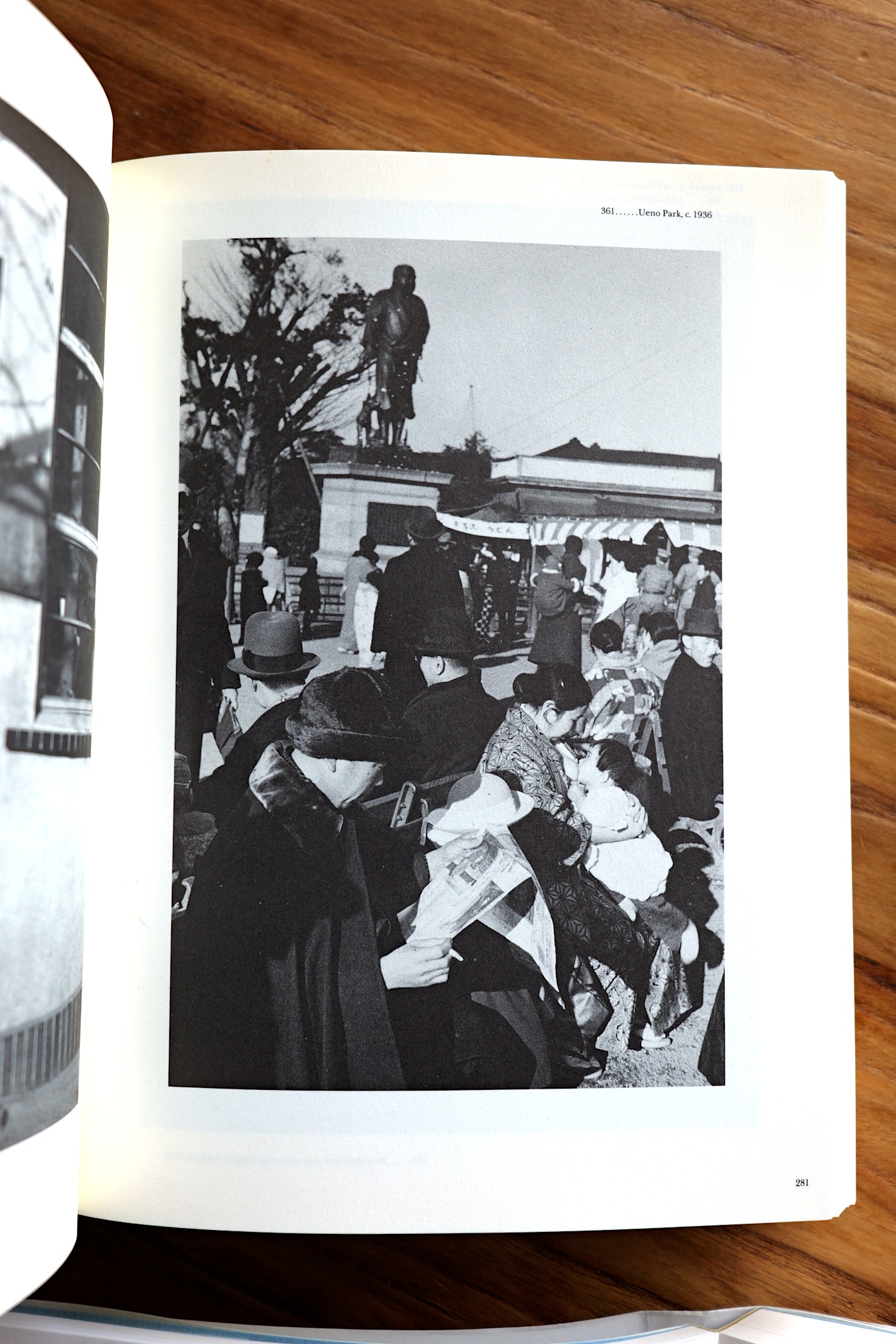
Here he is in a photo byUeno son Kineo Kuwabara. The statue had been up for thirty-nine years when Kuwabara snapped the shutter of his Leica then in 1937. This page is in his book 「Tokyo 1934-1993」 (Shinchosha, 1995). Thirty-nine (or so) years later in the 1970s, he took another from almost the same spot.
下谷生まれの写真家・桑原甲子雄が1937年に撮影した写真。桑原がライカのシャッターを切ったとき、この銅像は設置されてから39年が経っています。この写真は『東京1934-1993』(新潮社、1995年)に掲載されています。それから39年後の1970年代、彼はほぼ同じ場所から別の写真を撮っています。
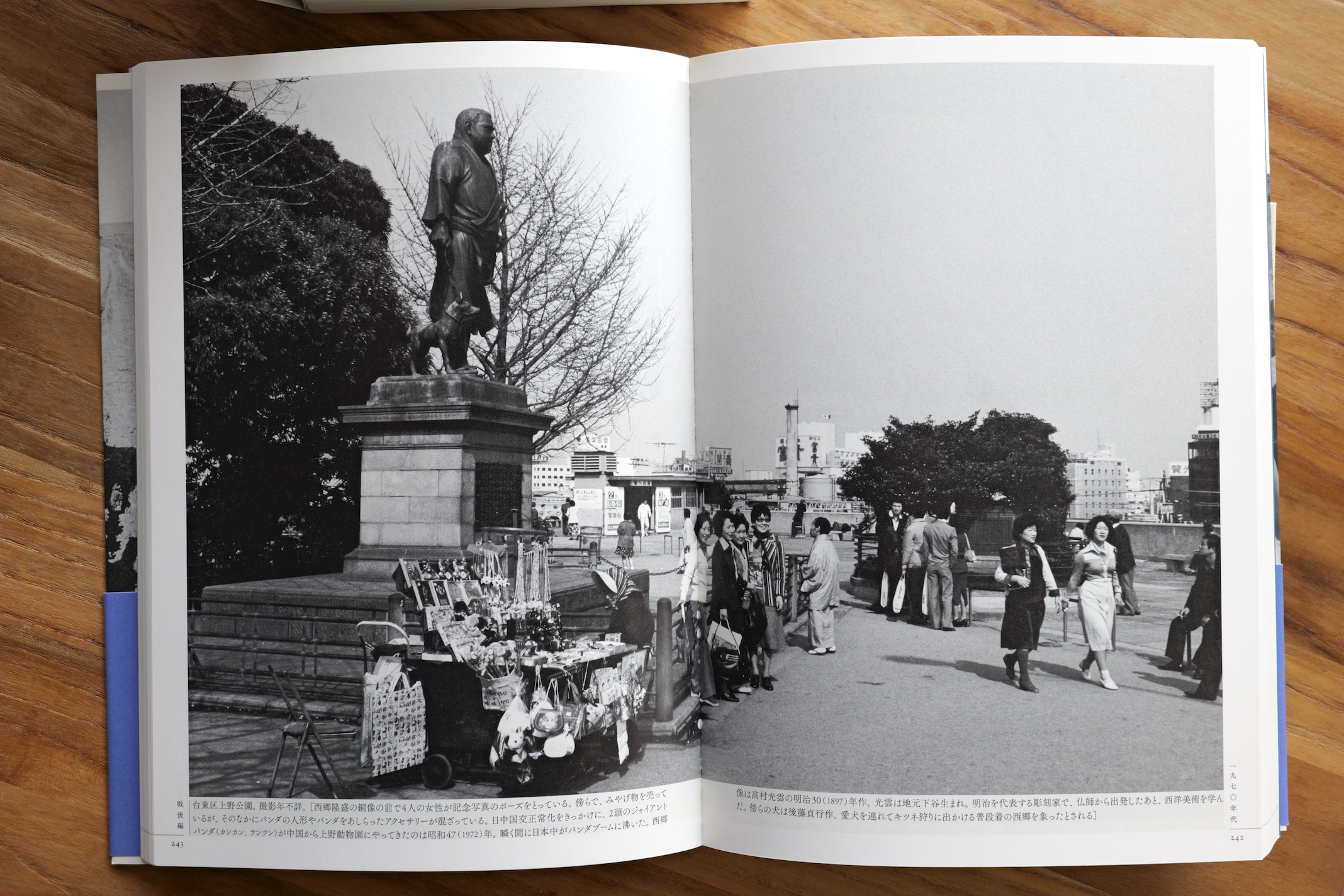
From “Kineo Kuwabara: Personal Recollection of the Showa Era”, Asahi Shimbun Press, 2013
桑原甲子雄写真集『私的昭和史』上巻・東京戦前篇
This statue is a photo-op for out-of-towners - in front of Saigo you’ll often find people posing for commemorative snapshots, with local old-timers reading the newspaper on nearby benches.
この銅像の前で記念撮影をする人たちや、近くのベンチで新聞を読む地元の老人たちをよく見かけます。賑やかなところです。

The color picture here near the statue’s pedestal is by Naoki Ishikawa, seen in his book “Nippon: Tokyo” (Super Labo 2018) Ishikawa’s angle of view is opposite of Kuwabara’s.
Kuwabara would have been standing about where the phone booth is for his two earlier pictures.
西郷像の台座付近のこのカラー写真は、石川直樹『ニッポン: 東京』(Super Labo, 2018)に掲載されています。アングルは桑原の写真とは逆ですね(桑原は電話ボックスがあるあたりに立っていたはず)。
Here are two more photos taken a few meters nearby:
さらに数メートル近くで撮った2枚の写真がこちらです。
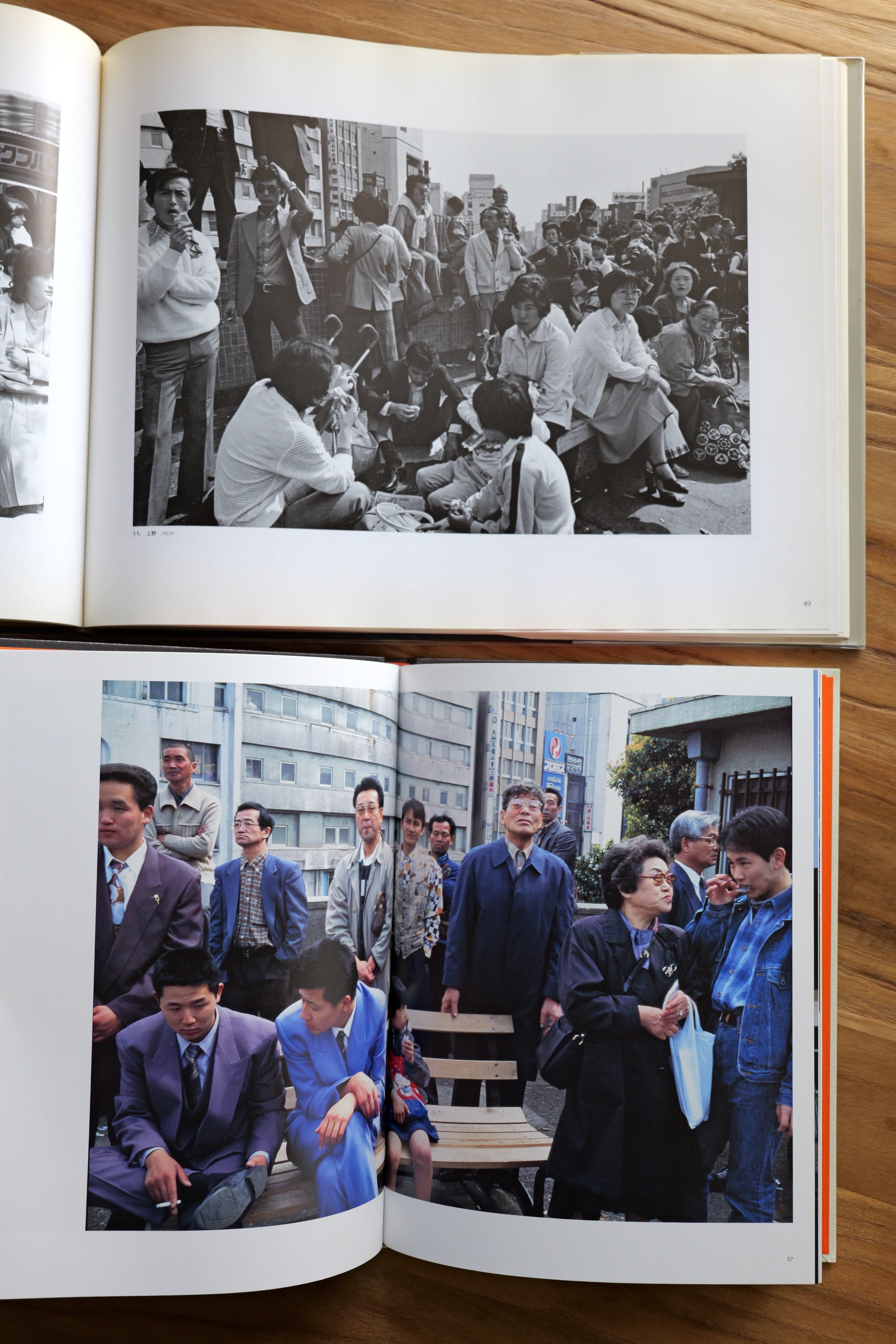
These snapshots were taken in the open area, facing away from the statue. The top image is from Hiromi Tsuchida’s “Counting Grains of Sand” (Toseisha, 1990 ). The color snap below is in Hiroyoshi Yamazaki’s “Smell on the Street” (Sokyusha, 2022).
これらのスナップ写真は、像に背に撮影されたもの。上の写真は土田ヒロミ『砂粒を数える』(東声社、1990年)、下は山崎弘義『路上の匂い』(蒼穹舎、2022年)です。
Stepping back a bit, we can see a broader view of the location (complete with Saigo & Tsun) on the following two pages. Interestingly (to me, anyway!), both were taken with Makina 67 cameras.
次の2枚は、そこから少し下がって撮影されています。興味深いことにどちらもマキナ67で撮影されています。
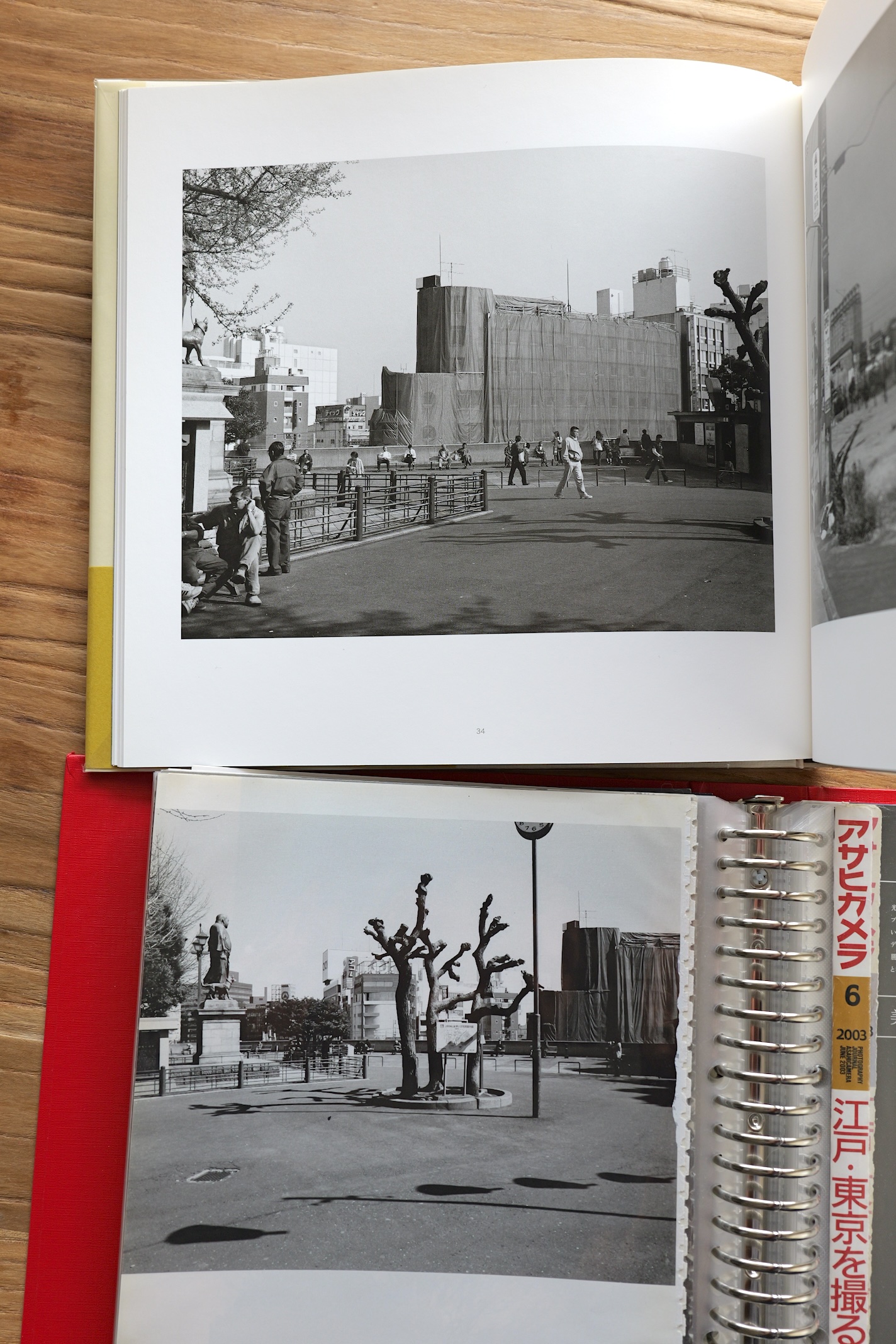
The image on top is by Mitsugu Ohnishi. It is in his book WONDERLAND 1997-2004, (Nippon Camera Publishing 2006). Below it is a photo by Nobuyoshi Araki that appeared in the June 2003 issue of Asahi Camera magazine, opening a feature titled “Tokyo, in Spring”. You can see that both images were made near the same time by the fact that the building in the background- an old hotel- was covered in netting prior to demolition. The Ueno branch of Yodobashi Camera currently stands on this spot. The trees in the foreground have grown, too.
上は大西みつぐ『WONDERLAND 1997-2004』(日本カメラ、 2006年)に収録されています。下の写真は『アサヒカメラ』2003年6月号の特集「春は、東京」の巻頭に掲載された荒木経惟の写真です。背景の古いホテルが取り壊される前のネットで覆われていることから、2枚の写真がほぼ同時期に撮影されたことがわかります。現在、この場所にはヨドバシカメラ上野店が建っています。手前の木々も大きくなりました。
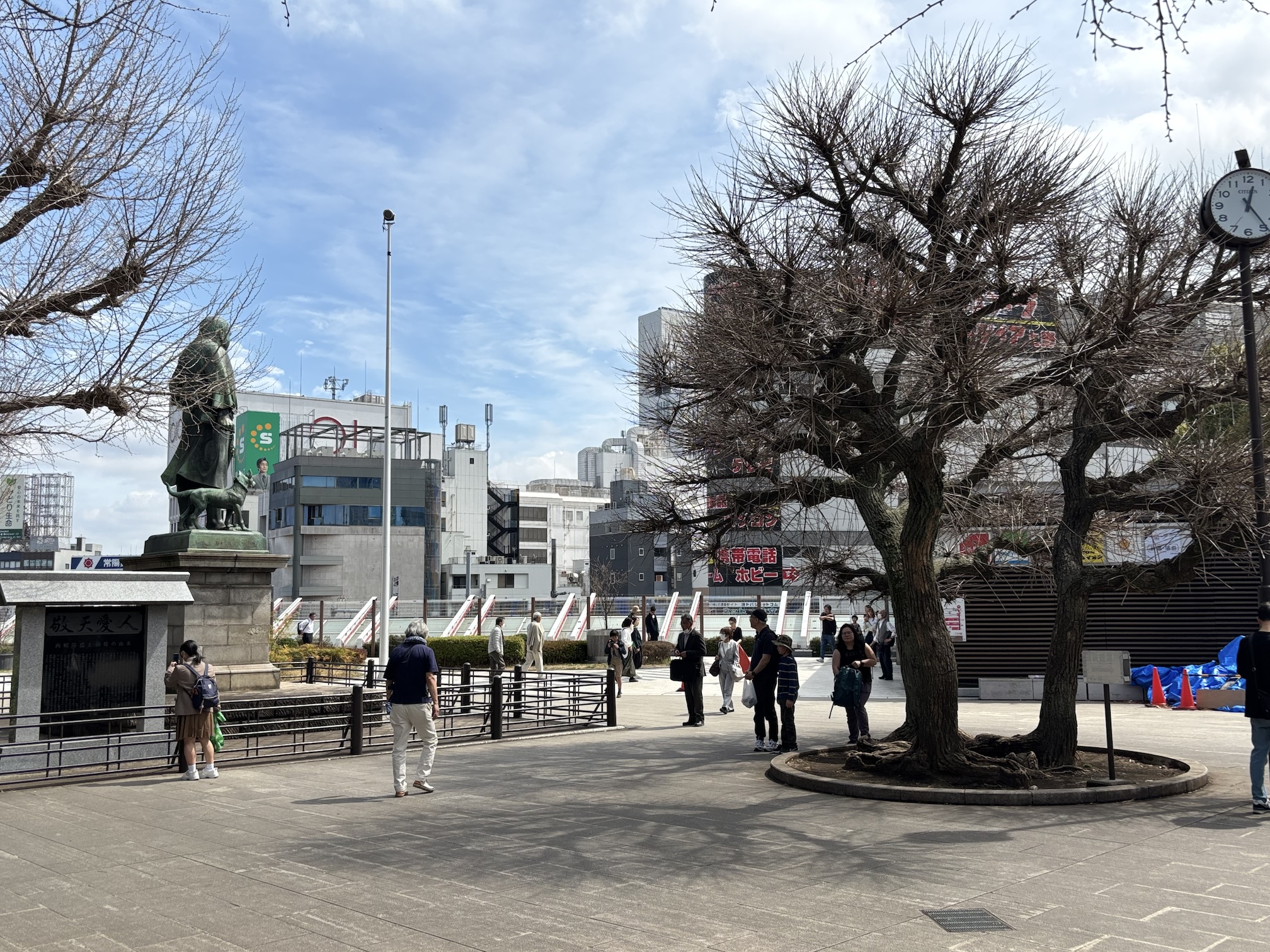
Leaving Ueno and crossing the Sumida river, another Ohnishi / Araki pairing can be made with the same copy of WONDERLAND & Araki’s “Bokuto Eros” (Kobunsha, 1994). These pictures were both taken from a small set of steps next to the entrance of Shirahige shrine in Mukojima, Sumida ward. This shrine sits near the Sumida river- which leads us to our next spot.
上野を出て隅田川を渡ると、大西みつぐ『WONDERLAND 1997-2004』と荒木経惟『濹東エロス』(光文社、1994年)でまたもや同じ場所が登場します。墨田区向島にある白鬚神社の入り口横にある小さな階段から撮ったものです。


Leaving Mukojima, the river flows south, passing Ryogoku station. Since the mid 1600s the Sumida has been spanned by a Ryogokubashi bridge. The current bridge was completed in 1932, and each of its four pillars sport a splendid, era-correct art deco concrete sphere.
隅田川を南にくだると両国駅です。1600年代半ば、隅田川には両国橋が架かっていました。現在の橋は1932年に完成したもので、4本の柱にはそれぞれ時代を反映した見事なアールデコ調のコンクリートの球体がついています。
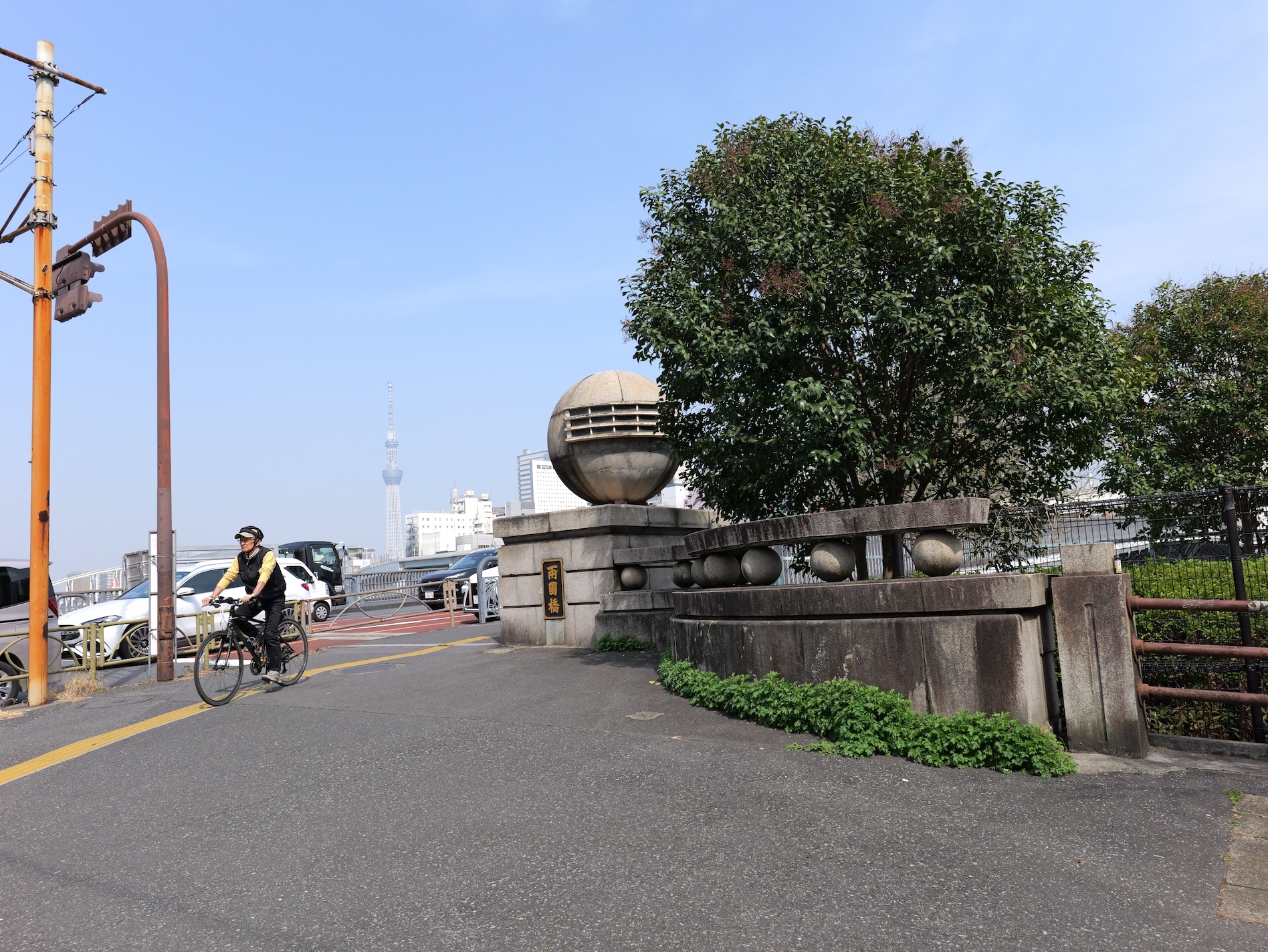
I made a visit the other day…making a point to match the angle of Araki’s photo, seen here in his book of cityscapes, Tokyo Boujo:
上の写真は、荒木経惟『東京慕情』(新風舎、1999年)の写真の角度を合わせて撮ってみました。

These concrete globes caught Suda’s Minox Camera-eye at least twice:
この強大なコンクリート製の球体は、ミノックスカメラを通して須田一政の目に少なくとも2回は映っています。

Top: Human Memory / Bottom: The Mechanical Retina on My Fingertips
上『人間の記憶』クレオ,、 1996年/下『網膜直結指先目カメラ』Zen Foto、2018年
I’m fascinated how- with all those 40,008 kilometers of Tokyo streets to choose from, just how often- and within so few meters- the lenses of Issei Suda and Nobuyoshi Araki overlapped.
Granted, both are/were prodigious photographers- But they’re also from the same era. In fact, they were both born in eastern Tokyo shitamachi downtown neighborhoods in 1940, just a month apart. (Suda on April 24, Araki on May 25). Here is another pairing of their photos- images taken in Asakusa mere meters- and a few years- apart:
東京の街で、須田一政と荒木経惟が何度も、しかもほんの数メートル間で重なり合ったことは不思議なことです。もちろん枚数的に2人ともものすごく写真を撮った人ですが、同時代の人です。2人とも1940年、一ヶ月違いで東京の下町で生まれました(須田は4月24日、荒木は5月25日生まれ)。
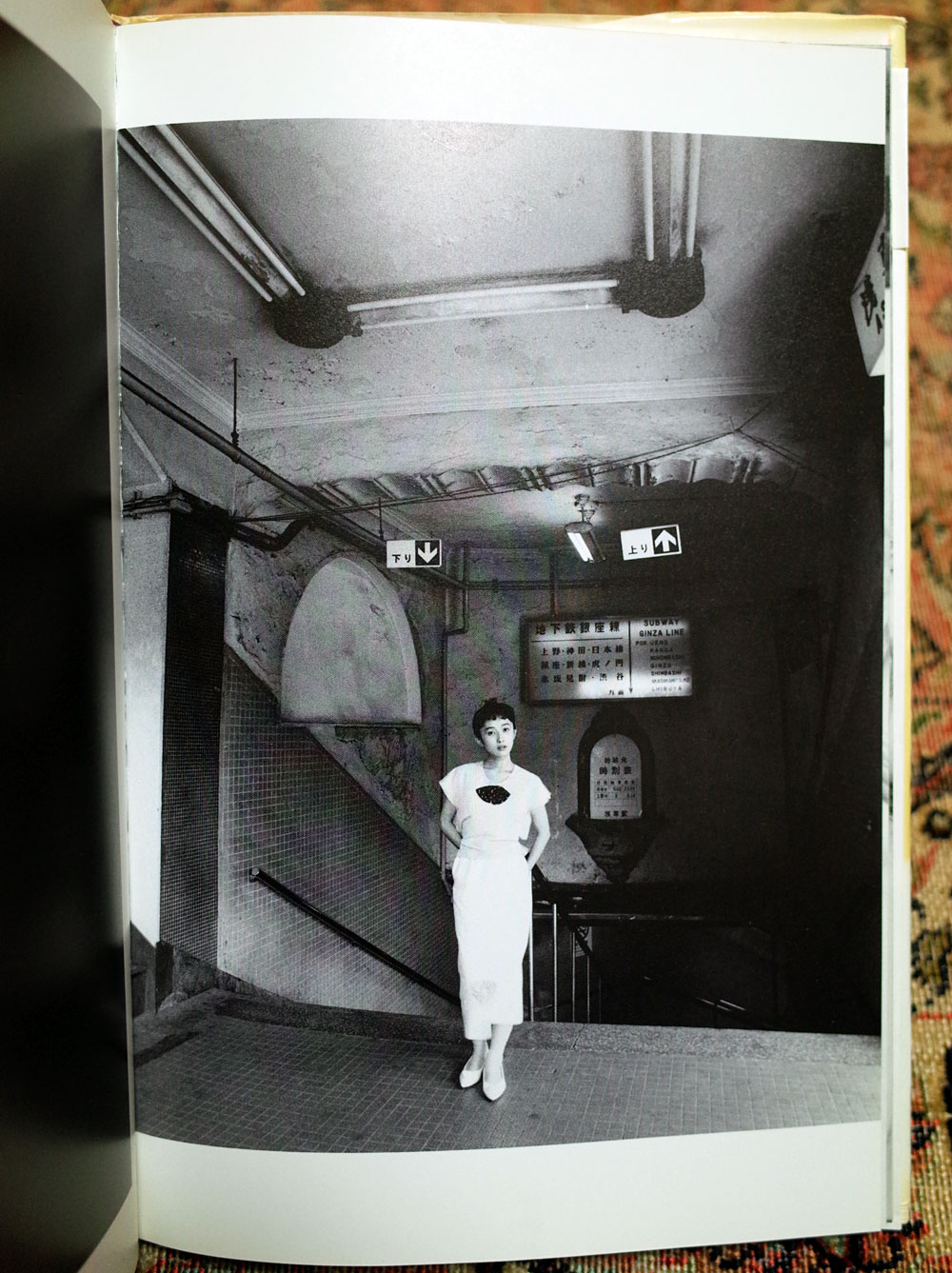
Nobuyoshi Araki "Pure Heart Photo Stories" Million Shuppan, 1989
荒木経惟『純情写真小説』ミリオン出版、1989年
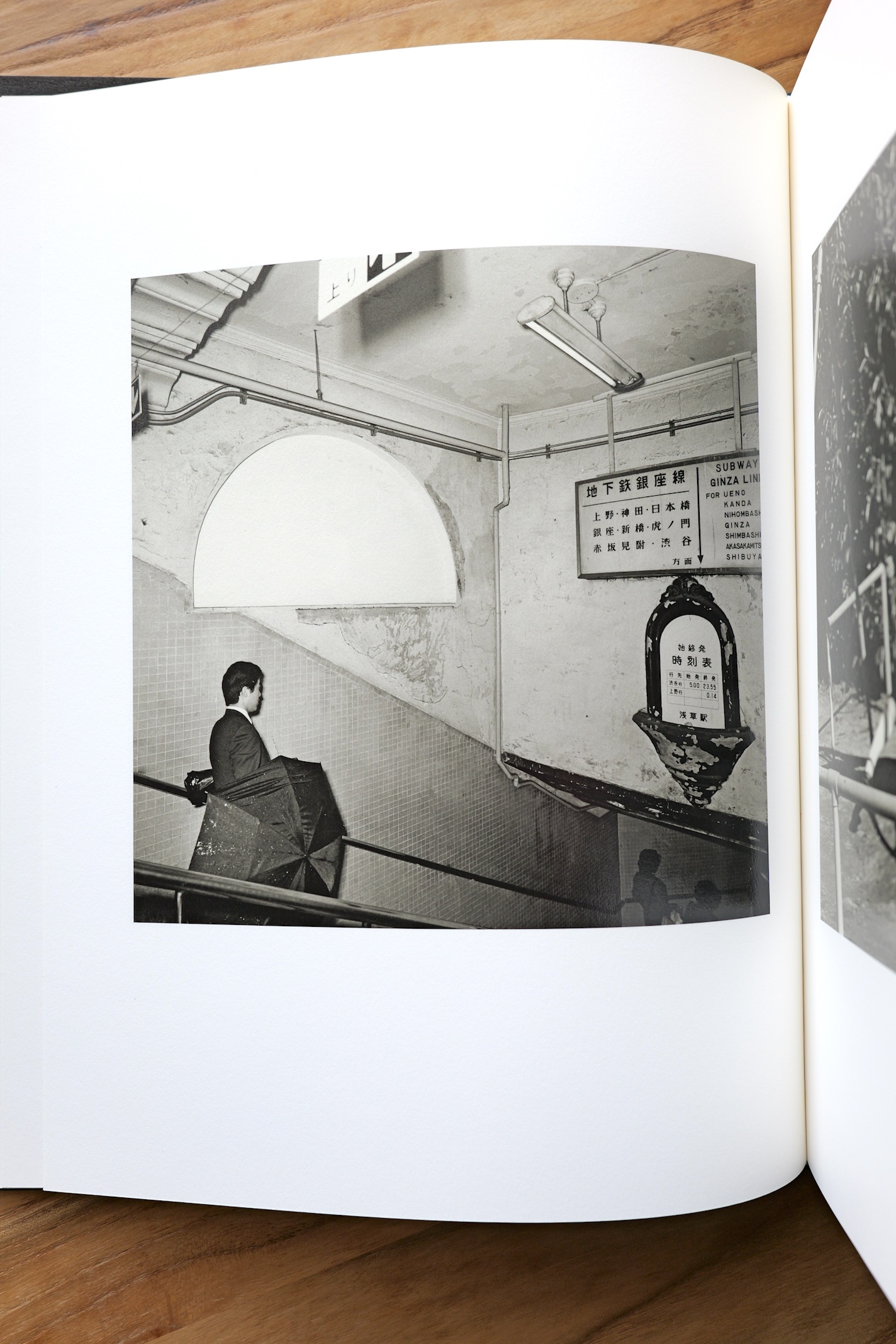
Issei Suda "Tokyo Kei" Zen Foto Gallery, 2013
須田一政『東京景』 Zen Foto Gallery、2013年
This location is the subway entrance of previous Kaminarimon building that sat on top of the Asakusa subway station. Even though the original 1929 building has been replaced, the wooden decorative relief on the right was saved and can be seen in the same location (framing a red lantern) today:
この場所は、地下鉄浅草駅の雷門ビルの地下鉄出入口です。1929年に建設された当時の建物は建て替えられてしまいましたが、右側の木製の装飾レリーフは保存され、現在も同じ場所で見ることができます。
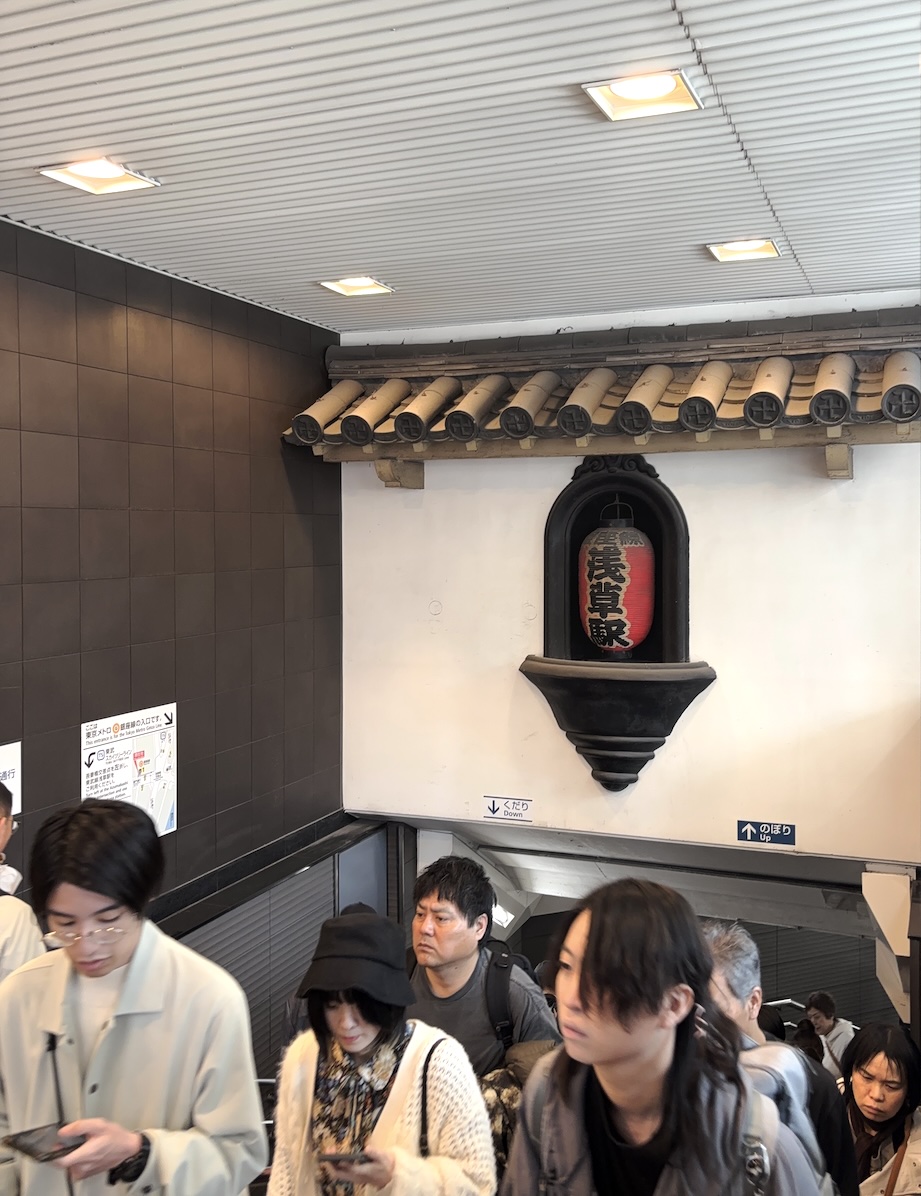
If you think that’s close, in the following two books you can see how both were drawn to the very same display window in Tokyo’s Yanaka neighborhood:
また、須田・荒木が谷中にある同じショーウィンドウを撮影した写真もあります。
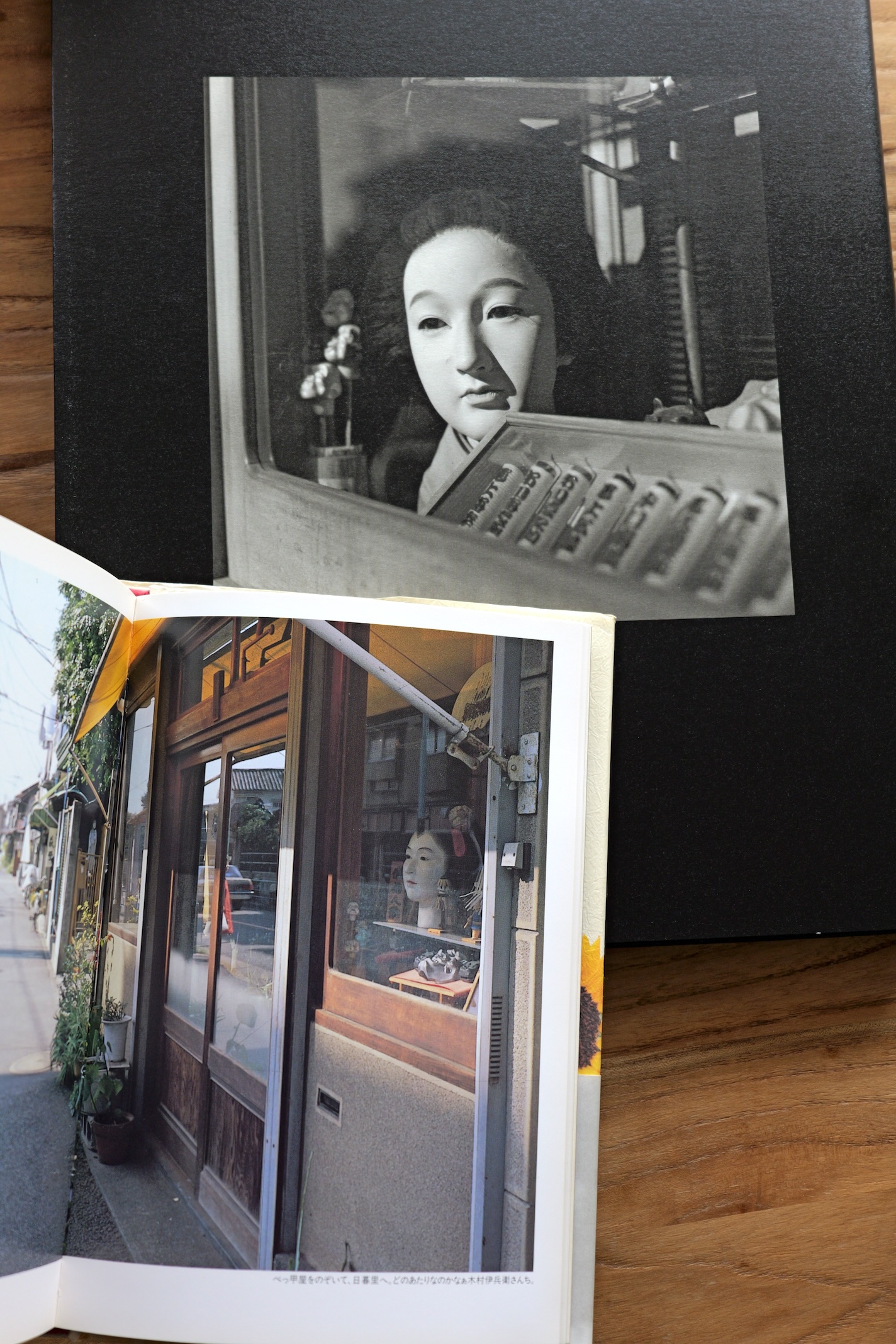
I have done some research on this shop- while the original building (and the show window) was demolished some years ago, the craftsman has a studio nearby. This studio continues to make these traditional doll heads for the Chrysanthemum festival held each October at Daienji temple down the street. Suda’s image, likely taken in the early 1980s, appears in (and on the rear cover of) Tokyo Kei.
Araki’s color picture, taken in the early 1990s with a Leica M6, is found in Tokyo Biyori (Chikuma Shobo, 1993 ).
須田の写真は1980年代初頭に撮影されたもので、『東京景』の中と裏表紙に掲載されています。荒木のカラー写真は1990年代初頭にライカM6で撮影されたもので、『東京日和』(筑摩書房、1993年)に掲載されています。この店について少し調べてみたところ、元の建物とショーウィンドウは数年前に取り壊されてしまいましたが、当時の職人がこの場所の近くに工房をかまえているそうです。この工房では毎年10月に大円寺で開催される菊まつりのために、この伝統的な人形の頭を作り続けています。
Fun fact: A photo of a doll from that studio (from that chrysanthemum festival) is on the cover of my book Tokyo Silver Paradise, published by Zen Foto Gallery.
実は、ここの職人さんが作った菊人形の写真が、Zen Foto Galleryから出版された私の写真集『銀園』の表紙を飾っています。

I honestly did not realize the Suda pairing / rhyme until after my book was printed. It’s important to understand that the kinds of parings I’m talking about here are not necessarily planned! In fact, I think it would be a complete mistake to think that any of these photographers were purposefully attempting to out-shoot or out-shine previous photographs. Like I said, these things and places have a power that draws lenses to them...
正直、この写真のペアリングに気づいたのは、私の写真集が印刷されただいぶ後でした。このような写真の組み合わせの多くは、無意識のうちに生まれていると思います。他の人が同じ場所で撮った写真を超えたい!と考えるとは思えません。これらの物や場所には、レンズを引き寄せる力があるのです。
Back to Araki and Suda in Yanaka. Both men have books that include a photo of this life-sized camel replica seen on the roof of a building just down the street from Yanaka Ginza (we’ll stroll over there in a second).
それでは谷中に戻ります。須田一政と荒木経惟、2人とも谷中銀座の近くにあるビルの屋上にある実物大のラクダのレプリカの写真を撮影しています。
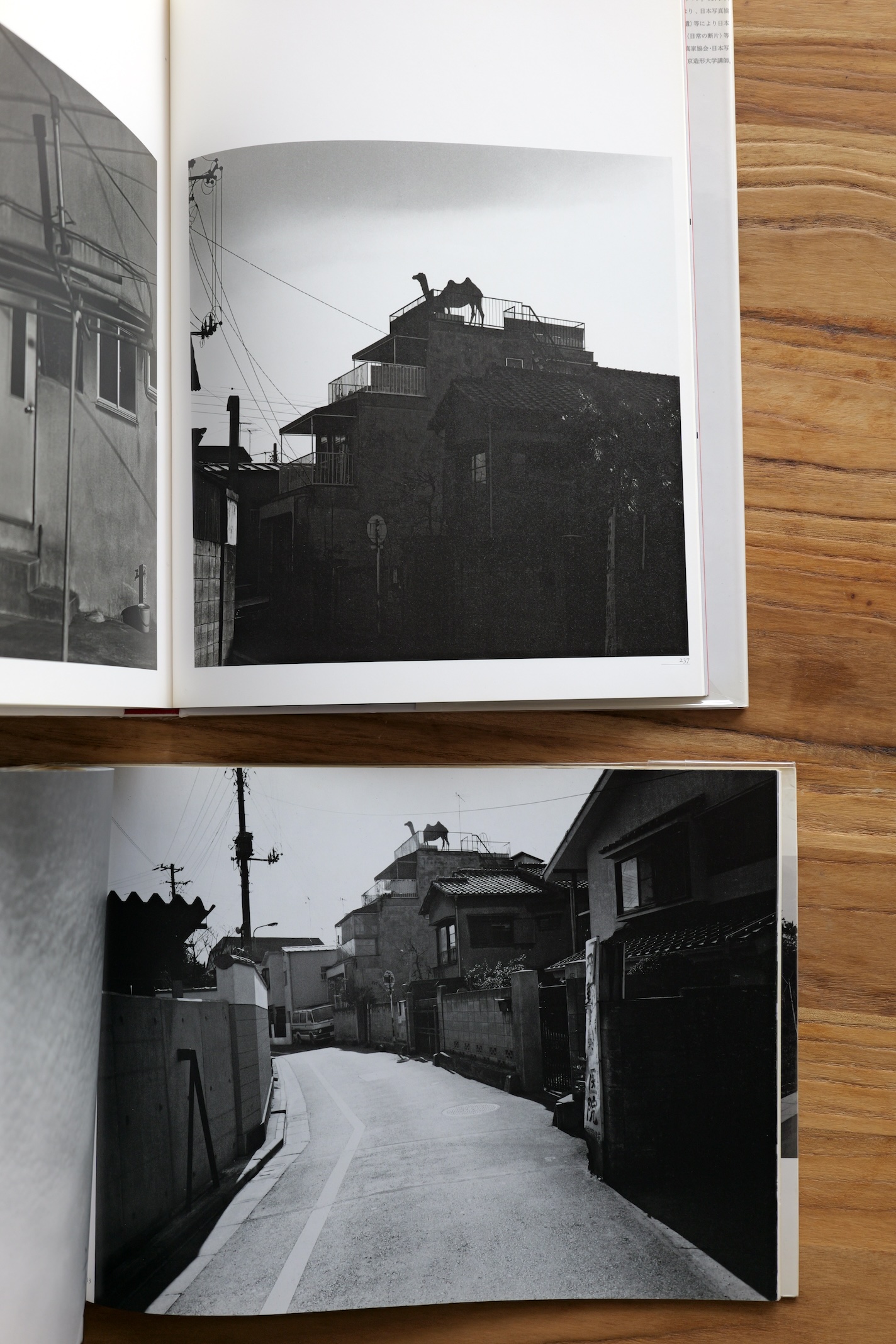
That’s Suda’s photo from Human Memory (Creo, 1996 ) on top, with Araki’s pulled-back view seen in Tokyo Story (Heibonsha, 1989) below.
Even though a new neighboring building blocks Araki and Suda’s original view, the camel is still there! Now pointing west, it continues to look out over the city from the roof of the contemporary art gallery Higure 17-15 cas (https://hgrnews.exblog.jp/ )
上は須田一政『人間の記憶』(クレオ、1996年)、下は荒木経惟『東京物語』(平凡社、1989年)です。ラクダがまだいるかどうか、谷中へチェックしに来ました。見つけることは難しくないですよ、かなりラクダ(笑)。現在ラクダは現代美術ギャラリー「higure 17-15 cas」の屋上から西方向を向いて、街を見渡し続けています。

In terms of his books, Araki’s camel photo was printed first in Tokyo Story (top) , reappearing in his 1999 book of 1980s cityscapes, Tokyo Boujo (bottom):
荒木が撮影したラクダは1989年の『東京物語』と、1999年の『東京慕情』に掲載されています。
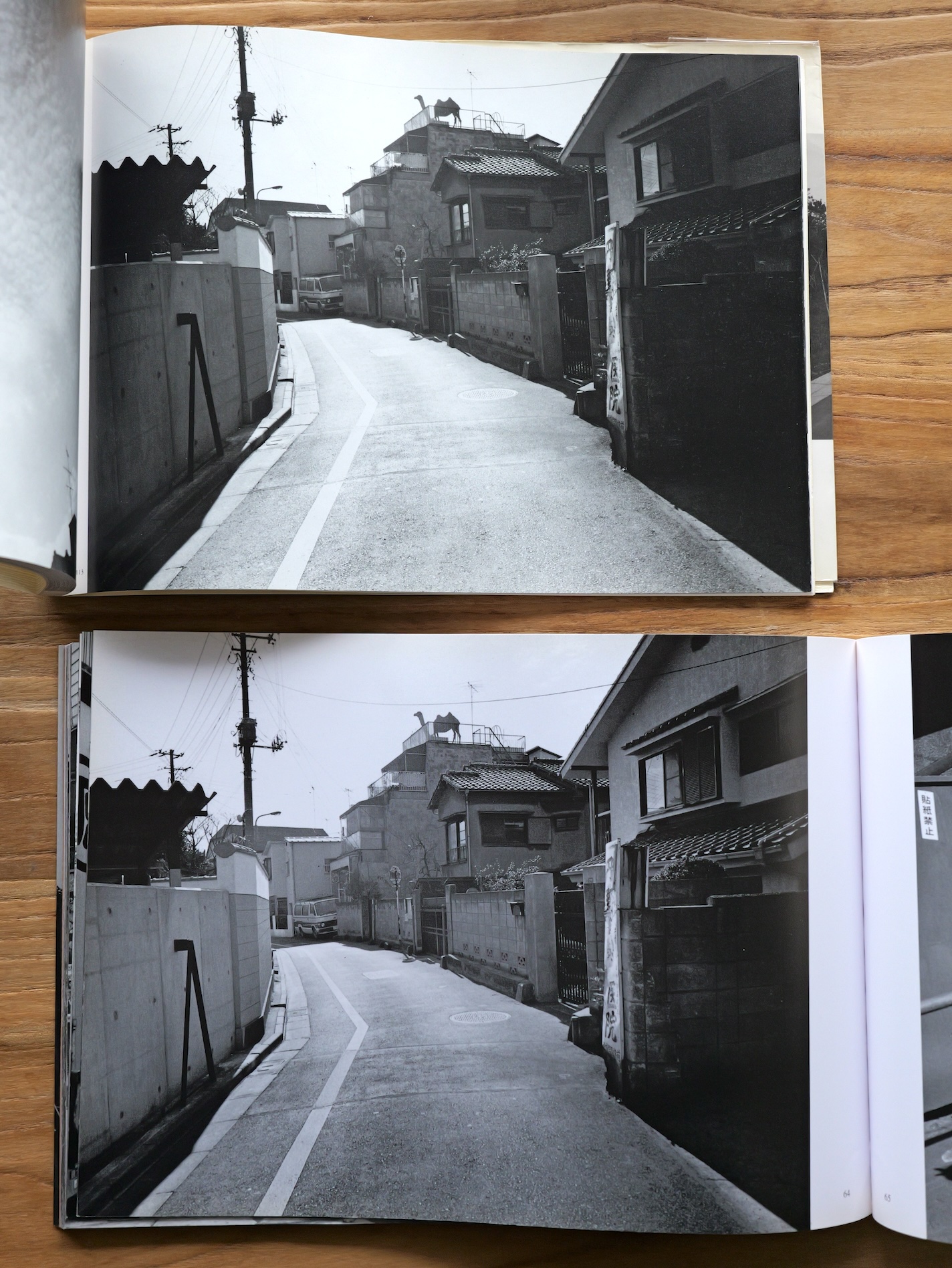
On facing page of the later book is a photograph taken about 100 meters east of the camel.
It’s of the staircase at the high end of Yanaka Ginza.
『東京慕情』のラクダの隣の写真は、谷中銀座の石段の下から撮られたものです。

And looking down from the top of these same stairs... Issei Suda took two photos that appear in his 1979 book, Waga Tokyo, 100 (Nikon Salon Books).
須田一政『わが東京100』には、その階段の上から撮った写真が2枚掲載されています。
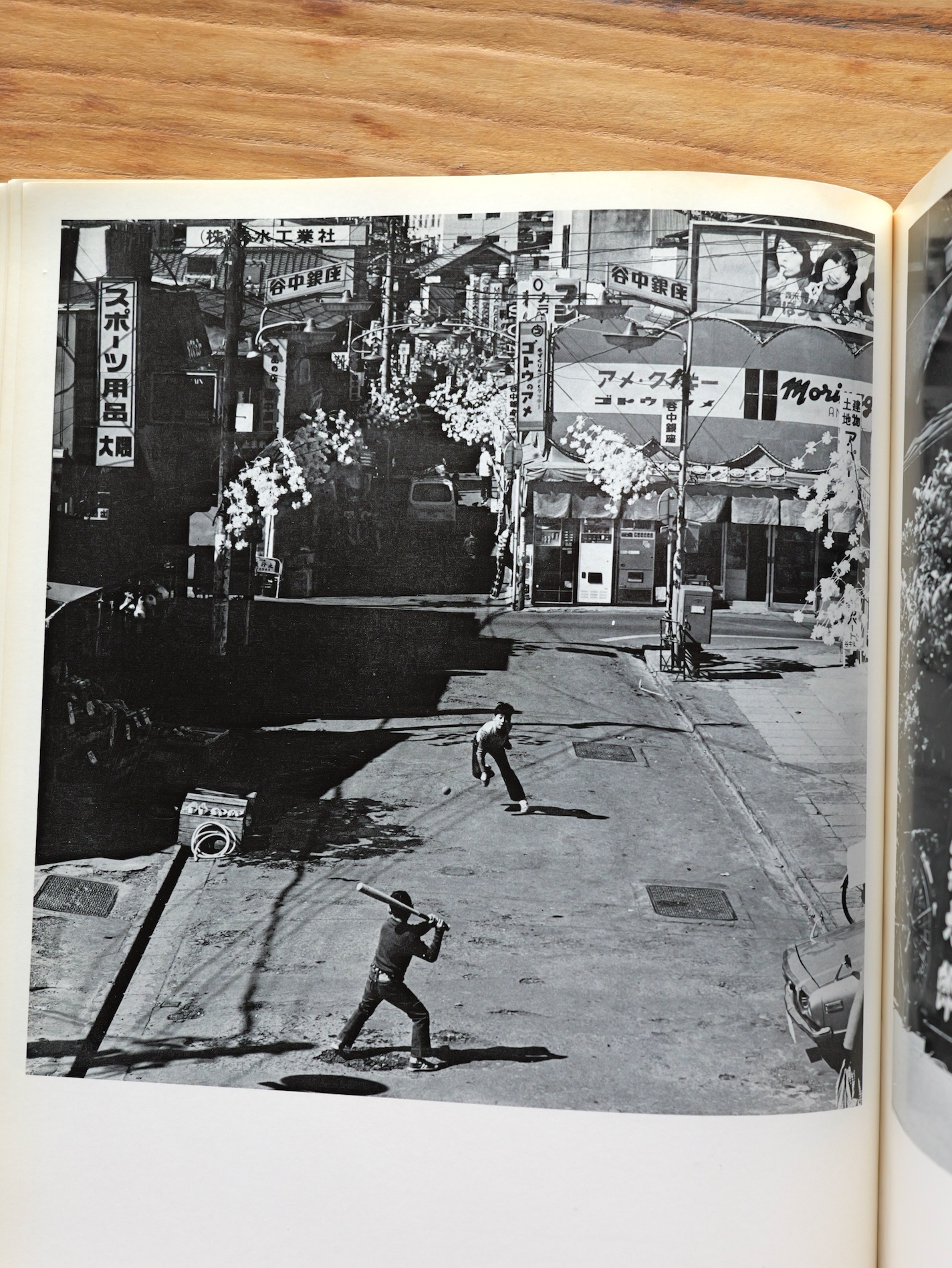
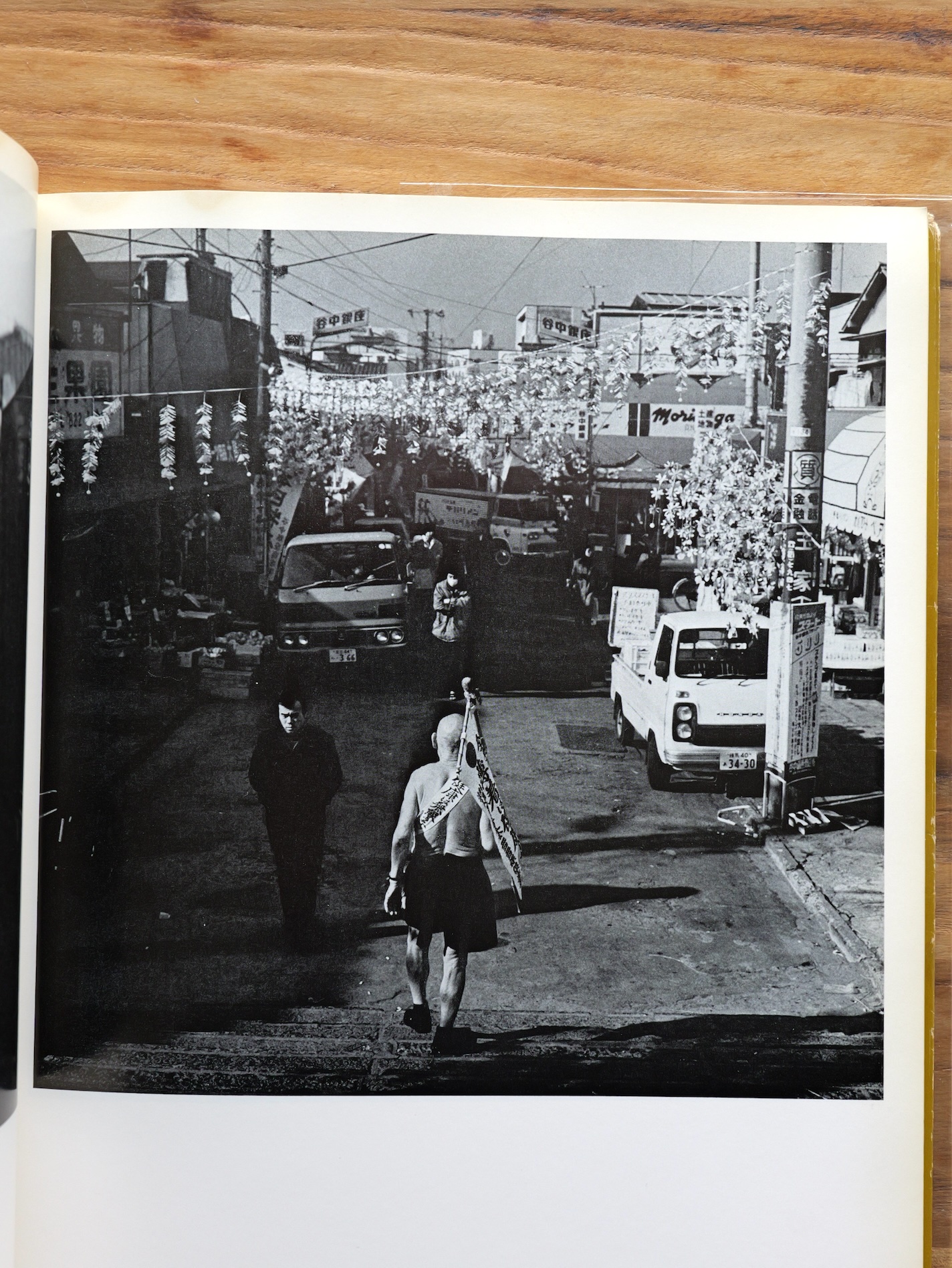
In recent years this westward-facing spot has become a well-known destination for insta-visitors, particularly in early evenings as the sun begins to go down. This spot offers such a great view of the sunset over Tokyo that decades ago these steps were officially named “Yuyake Dan Dan”. (“Sunset Stairs”)
近年この西向きのスポットは、特に日が落ち始める夕方の早い時間に、写真好きの人たちにとって有名な目的地になっています。数十年前、この階段は正式に「夕焼けだんだん」と名付けられました。これも荒木経惟と少し関係があります。

Back to Araki- a photo of his from this same spot at the top of the stairs can be found in his 1999 Yanaka-themed masterpiece, Hitomachi (Junposha). But that’s not all- Araki’s picture is a portrait of essayist and hitomachi co-author, Mayumi Mori. A Yanaka native, Mori explains in the book that the title, “Sunset Stairs” was the result of the town’s call for submissions from the public. And not only that, the winning title was her entry!
1999年の谷中をテーマにした荒木経惟の名作『人町』(旬報社、1999年)には、この階段の上の同じ場所からの写真が掲載されています。この写真はエッセイストで『人町』の共著者である森まゆみのポートレートです。谷中出身の森は著書の中で「夕焼けだんだん」というタイトルは、谷中町が公募した結果だと説明しています。それだけでなく、受賞したタイトルは森さんの応募作だそうです!
In a city as crowded with people and cameras as Tokyo, there are likely hundreds- if not hundreds of thousands- or even millions- of similarly-snapped photographs of these same places from over the years.
Whether published in a book or left unseen in old albums, each picture is a tesserae that, with each click of a shutter, is added to an ongoing, ever-expanding mosaic of time and space. Its entirety can never be fully realized- but with these kinds of glimpses understanding of it and the medium of photography can be deepened. It’s about keeping things interesting- and acknowledging the past and future when turning the pages of a photobook- or looking through a camera finder.
東京のように多くの人とカメラが行き交う都市では、同じ場所で同じような写真が、何百万枚と撮られていることでしょう。立派な写真集として出版されようが、個人アルバムに残されていようが、一枚一枚の写真はシャッターを切るたびに、時間と空間のモザイク画を構成するテッセラとなります。全体像を完全に把握することはできませんが、こうして見てみることで、写真というメディアに対する理解を深めることができます。写真集のページを捲る、またはカメラのファインダーを覗きながら、東京の過去と未来を認識し、物事に興味を持ち続けることは面白いです。


PCT Membersは、Photo & Culture, Tokyoのウェブ会員制度です。
ご登録いただくと、最新の記事更新情報・ニュースをメールマガジンでお届け、また会員限定の読者プレゼントなども実施します。
今後はさらにサービスの拡充をはかり、より魅力的でお得な内容をご提供していく予定です。
 「Photo & Culture, Tokyo」最新の更新情報や、ニュースなどをお届けメールマガジンのお届け
「Photo & Culture, Tokyo」最新の更新情報や、ニュースなどをお届けメールマガジンのお届け 書籍、写真グッズなど会員限定の読者プレゼントを実施会員限定プレゼント
書籍、写真グッズなど会員限定の読者プレゼントを実施会員限定プレゼント